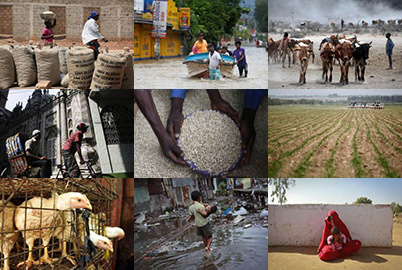A woman cries during a meeting in Baquba for displaced families. August 2008 REUTERS/Thaier al-Sudani
By Nabil Al-TikritiNot so long ago, the plains north of Mosul were home to a wide mix of ethnic groups living in neighboring villages. But drive through today and you will get an idea of how Iraq's ethno-sectarian map has been redrawn in the last five years. On a recent trip to the region I saw several settlements that had sprung up along the roadside. The taxi driver told me they were home to families who had been forced to flee their villages.
What has characterized this remapping? Nationwide, Kurds - along with prominent minority populations such as Assyrians, Chaldeans, and Yazidis -have fled north seeking shelter in districts controlled by the Kurdish Regional Government (KRG). Sunni Arabs, Ba'athists, and ranking former government officials have fled Baghdad and Southern Iraq, seeking refuge in neighboring Jordan, Syria, and central governorates such as al-Anbar, Salah al-Din, Ninewa, and certain specific neighborhoods of Baghdad. Finally, hundreds of thousands of Shi'a Arabs have fled Baghdad and Diyala provinces, primarily for governorates in Southern Iraq which constituted their family's "area of origin".
As a result, the simplistic tripartite (Sunni, Shi'a, Kurd) Iraq of American imagination has grown ever closer to becoming a geographic and philosophic reality. The areas of Northern Iraq controlled by the KRG have become dominated by Kurds, minorities, and certain Arab Sunni professionals who were able to flee to the region in the immediate wake of the invasion. Mosul has become far more dominated by Arab Sunnis, with its Christian and Yazidi populations pushed north into the KRG area - even as Arab Sunni peasants have been pushed south out of Yazidi-dominated Sinjar district. The city of Kirkuk has grown far more Kurdish, while Diyala province has lost much of its Shi'a Arab population. Finally, Baghdad has become a far more Arab Shi'a city, as has most of Southern Iraq.
Winners and losers abound in this new Iraq, and everyone is affected. In many cases, yesterday's refugees are today's government - which has greatly complicated government policy toward displacement. Council of Representatives Member Samia Aziz, a Shi'a Kurd (Fa'ili), remembers how a few days after the 1980 Iranian-backed attempted assassination of Deputy Prime Minister Tareq Aziz government agents turned up at the family home. Claiming that Fa'ili Kurds were acting as agents of Iran, they told her father and several other prominent Fa'ili merchants they were to be deported to Iran and must leave within a week. Now, nearly 30 years later, Aziz is seeking restitution of valuable family property in downtown Baghdad.
HOUSING SHORTAGEConflicting signals about potential returnees has further clouded the picture, putting simple solutions beyond reach. While returnees like Aziz await restitution, the new wave of forced migration ensures such disputes may well require adjudication for decades to come. Such chronological and geographical layers of displacement, combined with the complicated politics of winners and losers in the post-2003 political order, make it nearly impossible to imagine a viable national solution to forced migration and displacement.
International relief officials have faced some criticism for attempting to force off-the-shelf standard solutions on Iraq's unique situation. For example, one recently returned relief official criticizes the U.N. refugee agency (UNHCR) for demanding people have the right to return to their pre-war homes and refusing to consider internal resettlement, all the while insisting that the world take in and resettle all Iraqis living externally. He says this is simply unrealistic.
While such a stance is consistent with international law and UNHCR protocols, it does not fit a situation whereby much of the regional migration is circular in nature. In Iraq's reality, many individuals constantly move back and forth across borders and governorate boundaries in order to collect rent, check on properties, shift assets, rescue relatives, run businesses, and many other necessary activities. Under such a social paradigm, neither the legal distinction between international refugees and internally displaced, nor the policy solution, is nearly as clear as it's meant to be.
To further complicate the situation, Iraq has long suffered from a serious - albeit largely invisible - national housing shortage. As it turns out, the previous regime had failed to initiate significant housing construction since roughly the mid-1980s. With Iraq's population continuing to grow in spite of wars, sanctions, and mass violence, well over 20 years of housing construction inactivity has left a woefully inadequate housing stock for today's population to fight over.
Meanwhile, layers of displacement continue to aggravate sectarian violence, as witnessed last month in Diyala province. In a single week, central government officials moved to detain U.S.-backed Sunni Arab neighbourhood patrol units in Diyala's capital Ba'quba; a suicide bombing attack killed some 25 police recruits in Ba'quba; and U.S.-backed KRG officials tried to register a few thousand Kurds as local residents in Khanaqin, a town in northern Diyala contested by both Kurds and Arabs.
Iraq's displacement issues have largely rendered today's international policy norms irrelevant, have heightened sectarian tensions and made refugee returns unlikely. Is there any hope? Without a set of initiatives to build tens of thousands of new housing units, equitably adjudicate an impressively complicated tangle of legal property claims, and provide security for all who wish to attempt a return to their rightful homes, no easy solution lies within reach.
Nabil Al-Tikriti is Assistant Professor of History at the University of Mary Washington in Virginia, United States.Our Standards: The Thomson Reuters Trust Principles.

